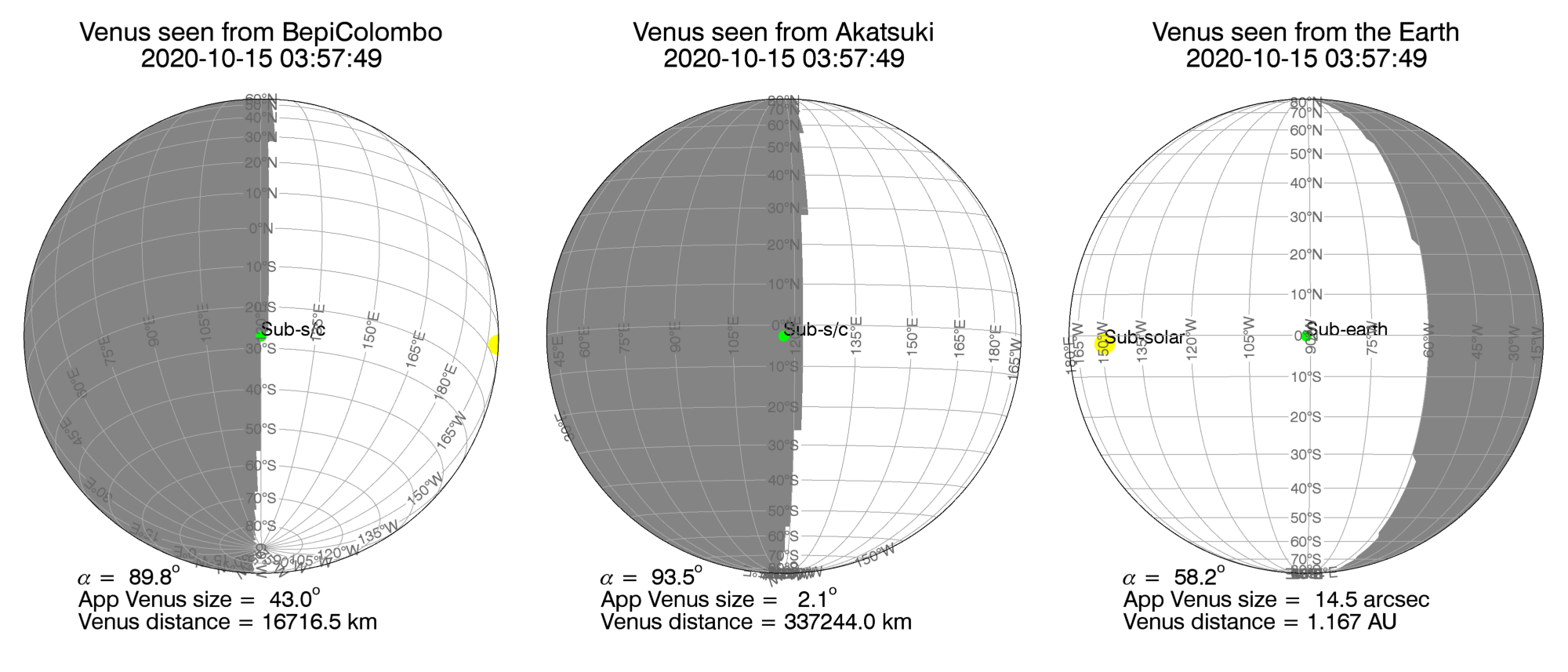Other services: Planetmap | Junocam | Jovian impacts | Venus BepiColombo Flyby
2020-10-13
 The ESA/JAXA mission BepiColombo will flyby Venus on 15 October at an altitude of 10,720 km above Venus surface. It will observe the planet from 13 October to 17 October with a closest approach on 15 October at 03:58 UT. This will be the first of two flybys to Venus, with the second one scheduled for 10 August 2021 at a very close altitude of 550 km. We would like to invite you to get Venus observations over these days and up to October 21 with emphasis on the closest approach of 15 October. Venus cloud tops observable in the UV rotate around the planet once every 4 days and observations from 11-12 October will characterize the details observable at the time of the closest flyby on 15 October. Observations on 19-20 will be able to characterize the next rotation. Long infrared filters (IR810, methane filters and 1000nm) can be used to study the dynamics of lower levels of the clouds where the atmosphere rotates once every 5 days and where large structures recently discovered and not yet fully understood can be observed (see for instance the following
observations from Manos Kardasis from March 2020.)
The ESA/JAXA mission BepiColombo will flyby Venus on 15 October at an altitude of 10,720 km above Venus surface. It will observe the planet from 13 October to 17 October with a closest approach on 15 October at 03:58 UT. This will be the first of two flybys to Venus, with the second one scheduled for 10 August 2021 at a very close altitude of 550 km. We would like to invite you to get Venus observations over these days and up to October 21 with emphasis on the closest approach of 15 October. Venus cloud tops observable in the UV rotate around the planet once every 4 days and observations from 11-12 October will characterize the details observable at the time of the closest flyby on 15 October. Observations on 19-20 will be able to characterize the next rotation. Long infrared filters (IR810, methane filters and 1000nm) can be used to study the dynamics of lower levels of the clouds where the atmosphere rotates once every 5 days and where large structures recently discovered and not yet fully understood can be observed (see for instance the following
observations from Manos Kardasis from March 2020.)
We warmly invite you to get observations that will help us characterize motions, cloud morphology and changes in Venus cloud fields over the time scale of 2-3 rotations around the planet (8-13 days). Some of you have obtained fantastic observations of Venus surface with combinations of filters close to 1 micron isolating the narrow bands at 1.0, 1.05 and 1.1 microns where the surface becomes observable. Such observations are also highly welcomed.
BepiColombo will observe Venus thermal emissions from 7 to 14 microns obtaining global images of the temperatures at the cloud tops and above the clouds and will obtain detailed spectroscopy in the UV from 145 to 315 nm. Images in the UV and 10 microns (also reflecting thermal properties of the atmosphere at the upper clouds and above) will be obtained by the Akatsuki orbiter. The amateur contribution might provide most of the temporal context of the cloud fields to the BepiColombo spectra and will be very valuable to the mission.
More information: